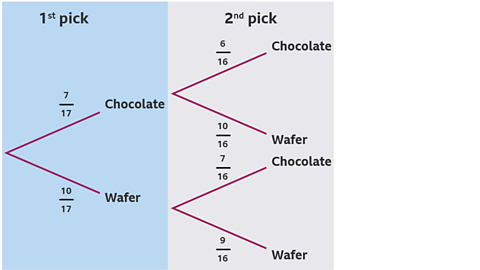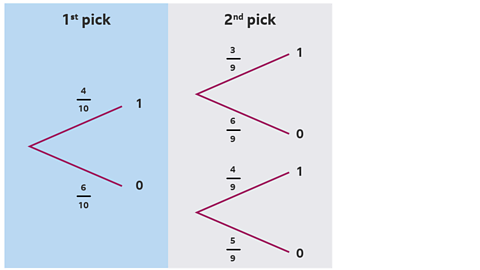This module builds on M7 Probability.
Events that are not independent
Two events are independent if the probability of the first event happening has no impact on the probability of the second event happening.
If the probability of one event happening affects the probability of other events happening, then the two events are not independent.
Example
A sock drawer contains 5 white socks and 4 black socks. A sock is taken at random and put on. Another sock is taken and put on. What are the probabilities of the different sock pairings?
In this example, a sock is taken and not replaced in the drawer. This means that the next time a sock is picked, one of the socks will be missing. This will affect the remaining probabilities.
In this tree diagram, a white sock has been selected and put on, so there are no longer 5 white socks in the drawer. There are only 4. The total number of socks has also gone from 9 to 8.
So the probabilities of the different sock pairings are:
two white socks – \(\frac{5}{9} \times \frac{4}{8} = \frac{20}{72}\)
one white sock and one black sock – \(\frac{5}{9} \times \frac{4}{8} + \frac{4}{9} \times \frac{5}{8} = \frac{40}{72}\)
two black socks – \(\frac{4}{9} \times \frac{3}{8} = \frac{12}{72}\)
Question
Ross has a biscuit tin containing 10 wafer biscuits and 7 chocolate biscuits. He chooses one at random and eats it. He then chooses a second at random.
Complete the probability tree.


Question
Using the completed probability tree from the previous question, find the probability that Ross chooses two biscuits that are the same.

There are two ways that Ross can choose two biscuits that are the same:
- chocolate followed by chocolate
OR
- wafer followed by wafer
So:
\(P(\text{chocolate chocolate}) = \frac{7}{17} \times \frac{6}{16} = \frac{42}{272},\) – follow the branches, multiplying the probabilities
\(P(\text{wafer wafer}) = \frac{10}{17} \times \frac{9}{16} = \frac{90}{272}\) – follow the branches, multiplying the probabilities
\(P(\text{chocolate chocolate OR wafer wafer}) = \frac{42}{272} + \frac{90}{272} = \frac{132}{272}\)
Question
For a game of binary bingo, CiarГЎn has a bag containing 6 discs with a '0' on them and 4 with a '1' on them.
He chooses one at random and puts it on the table and then chooses a second also at random.
- Draw a probability tree to represent his choices and use it to find the probability of choosing a 0 followed by a 1.

\(P(0, 1) = \frac{6}{10} \times \frac{4}{9} = \frac{24}{90}\)
What is the probability of the two discs having different numbers?
Answer
There are two ways this can happen:
- 0 and then 1
OR
- 1 and then 0
\(P(0,1) = \frac{6}{10} \times \frac{4}{9} = {24}{90}\)
\(P(1,0) = \frac{4}{10} \times \frac{6}{9} = {24}{90}\)
Probability of different numbers \(= \frac{24}{90} + \frac{24}{90} = \frac{48}{90}\)